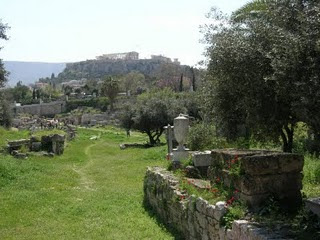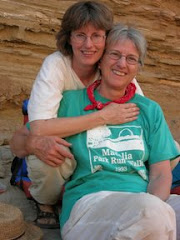For a free download of the KFAI radio show Becky and I did with MN State Representative Carolyn Laine on home funeral, green burials, and the new law that gives Minnesotans more choices for caring for our own dead, go to http://rcpt.yousendit.com/1110522769/b30b198f524539954d7281c3b6807917 . This Health Notes show, hosted by Kinshasha Kambui, was rebroadcast last week with a live update from Rep. Laine. The link will be active until May 17, 2011.
Nancy
Thursday, May 5, 2011
An Ancient Green Cemetery
 As Becky and I approach Kerameikos, we know it is different from the other archeological sites we had visited in Greece. It is the land that received many thousands of bodies for over 1500 years, the most important cemetery of ancient Athens. The earliest tombs date from the Early Bronze Age (2700-2000 BCE). Athenians continued burying their dead there until approximately the 6th century CE (Current Era).
As Becky and I approach Kerameikos, we know it is different from the other archeological sites we had visited in Greece. It is the land that received many thousands of bodies for over 1500 years, the most important cemetery of ancient Athens. The earliest tombs date from the Early Bronze Age (2700-2000 BCE). Athenians continued burying their dead there until approximately the 6th century CE (Current Era).On display in a small museum at the entrance are prehistoric grave offerings, tall urns that held ashes of the deceased, and archaic tombstones inscribed with expressions of grief over the loss of loved ones. One ornate chest is labeled ossuary, used where burial space was scarce. A body is buried in a temporary grave, and after some years
 the skeletal remains are removed and placed in the chest, making it is possible to store the remains of many people in a single tomb.
the skeletal remains are removed and placed in the chest, making it is possible to store the remains of many people in a single tomb.At the far end of one room stands a graceful life-sized statue of Nemesis, the spirit of divine retribution against those who succumb to hubris (arrogance before the gods). Becky and I marvel again at the powerful Godesses and human females depicted in ancient Greek art as well as the sculptors' skill in chiseling such realistic draped clothing.
The most interesting sign was about the Plague that struck in 430 BCE, killing thousands of Athenians. Physicians had no idea how to treat their patients and died themselves in large numbers. Each morning, the bodies were picked up, often near public fountains where the victims had tried to quench their terrible thirst. In violation of Athenian burial law, the corpses were dumped into a mass grave in Keramikos.
Outside the museum, sun-drenched and tree-shaded paths wind through ancient gavesites and the foundations of buildings and walls. (The Acropolis with its magnificent temple to Athena, is visible in the background.) Although we don't see any families lounging on the grass, my mother would have recognized this as a "fine and private place" for a picnic. Proponents of natural cemeteries can applaud Athens
 for maintaining this prime real estate as a public green space. Of course, Kerameikos was also green in the environmental sense: no embalming fluids, metal caskets, or concrete burial vaults went into the earth here. The cemetery, however, was full of marble tombstones, which contemporary green burial grounds do not include.
for maintaining this prime real estate as a public green space. Of course, Kerameikos was also green in the environmental sense: no embalming fluids, metal caskets, or concrete burial vaults went into the earth here. The cemetery, however, was full of marble tombstones, which contemporary green burial grounds do not include.Once again, I'm reminded of "time's winged chariot hurrying near." Whether we succumb to hubris or live humbly, remorseless Nemisis pushes us toward the grave. May we drink deeply from the fountain and love our dear ones while we can.
Nancy
Labels:
Athena,
Athens,
Green Cemetery,
Kerameikos Cemetery,
Nemesis,
ossuary,
Parthenon,
Plague
Wednesday, April 6, 2011
Becky's article just published
 Becky has an article in the premier issue of Natural Transitions Magazine on how a few citizens from the Minnesota Threshold Network with no funding and little legislative experience managed to change Minnesota state funeral law.
Becky has an article in the premier issue of Natural Transitions Magazine on how a few citizens from the Minnesota Threshold Network with no funding and little legislative experience managed to change Minnesota state funeral law. This first issue of Natural Transitions Magazine features beautiful graphics, interesting stories, and excellent resources on the home funeral movement and green burial movement in the US and other countries. To subscribe visit http://www.naturaltransitionsmagazine.com/. To link to a preview, or buy a single issue, visit www.magcloud.com/browse/Issue/171570
Photo at Minnesota State Capitol, April 6, 2010. L to R: Heather Halen, Marianne Dietzel, Nancy Manahan, Rep. Carolyn Laine, Becky Bohan, Kim Pilgrim.
Subscribe to:
Comments (Atom)

